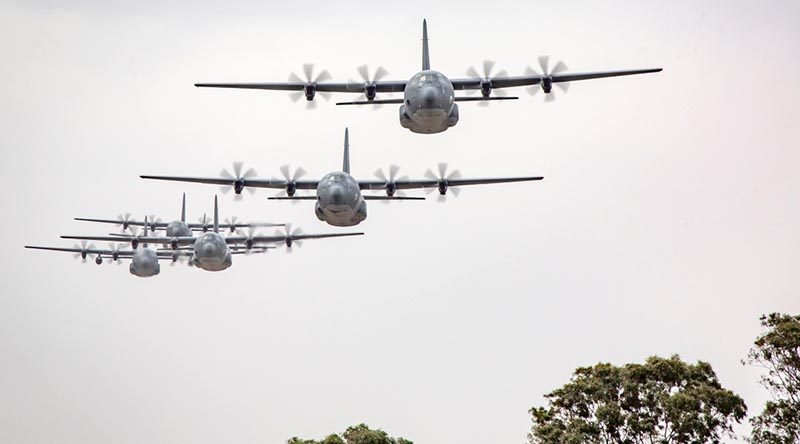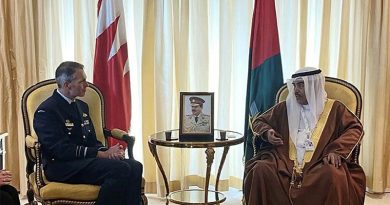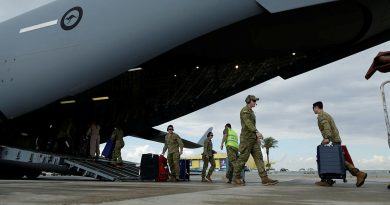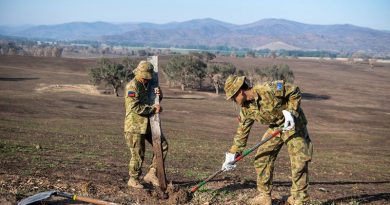RAAF increasing Herc fleet with 20 new C-130J
Share the post "RAAF increasing Herc fleet with 20 new C-130J"

Royal Australian Air Force will receive 20 new C-130J Hercules to replace the 12 currently operated by No. 37 Squadron at RAAF Base Richmond, NSW – expanding Australia’s fleet by nearly 70 per cent.
FILE PHOTO: C-130J Hercules aircraft from No.37 Squadron fly in formation over RAAF Base Richmond. Photo by Corporal Craig Barrett.
Valued at for $9.8 billion, this contract will begin delivery of the first aircraft in late 2027.
Minister for Defence Richard Marles said the Australian Defence Force relied on the C-130J Hercules for the deployment of personnel, equipment and humanitarian supplies.
C-130J has been involved in almost every major Defence operation in recent decades, from Bougainville assistance and Timor-Leste peacekeeping through to conflicts in Iraq and Afghanistan,” Mr Marles said.
“We are committed to ensuring the ADF is equipped with the capabilities it needs to keep Australians safe, and this targeted expansion of the fleet size will do just that,” Mr Marles said.
“The C-130J Hercules is an important capability for our defence force, but also for Australia as a nation.”
C-130J Hercules are made by Lockheed Martin and are being purchased from the United States.
These aircraft will continue to be operated by No. 37 Squadron at RAAF Base Richmond in NSW.
CEO Lockheed Martin Australia and New Zealand Warren McDonald congratulated Defence on its commitment to procure a new and expanded C-130J fleet.
“These aircraft will add to the 65-year legacy of continuous C-130 operations by Australia,” Mr McDonald said.
“The C-130J has proven its ability to meet all of Australia’s medium air mobility requirements and is an excellent choice to support [Australian] operations.”
.
.

.
.
Share the post "RAAF increasing Herc fleet with 20 new C-130J"






If two new Airbus tanker aircraft are on the shopping list, I wonder if one of them will be kept in standard format so that Albo can continue to fly around the world in this lovely big aircraft. Flying in a tanker may not be Albo’s favourite. It’s all about image.
Australia’s current inventory is made up of the C-130J-30 model which is a stretched version of the C-130J. It is not clear from the press release which model they are referring to for the new fleet.
An upcoming acquisition of 2 additional KC-30 air refuelers has also been announced. These are MRTTs and can also serve in the strategic air lifter role. However, these are large aircraft, and need long runways, which are few and far between in the archipelago of Australia’s northern approaches.
Australia’s C-130J-30s can land and take off on a suitable beach if required, and with a bit of modification can do so on ice as well. They can carry additional wing fuel tanks, defensive aids, and EO sensors. C-130J-30s can make use of the Rapid Dagon palletised munitions system to launch long-range cruise missiles, which allows them to serve as a stand-off bomber. C-130J-30s can also be converted into the Sea Hercules configuration to provide maritime patrol and ASW capability. This makes them an excellent choice for Australian requirements.
The C-17 production line has closed down, so we won’t be getting any more of those.
The C-27J Spartans are useful because they can also operate from austere runways, like those found in PNG, but they are expensive to operate and maintain. However, Alenia Aermacchi offer an MC-27J Praetorian upgrade kit that provides enhanced capability and the flexibility to support special forces, command and control, ISR, SIGINT, combat support, and combat search and rescue missions. Roll on/roll off options include an AESA search radar, EO/IR sensors, ESM, a palletised munition system, and an enhanced communications system providing data links and SATCOM. It also has 2 wing hard points to deploy precision guided munitions, a palletised fire support system that can fire out the rear door, and a defensive aids suite. The Italians also have a EC-27J Jedi electronic warfare upgrade path which provides radar jamming, and the disruption of radio communications including the remote detonators used by improvised explosive devices. So, we should keep these, and upgrade them … even if they are expensive.
Air mobility is an essential component of Australia’s war fighting capability so this modernisation and expansion of the tactical air lifter fleet should be applauded.
A welcome decision. This is one of the most capable and versatile airlift platforms available on the planet. The UK just did the opposite getting rid of its aging Hercules instead opting to rely only on Airbus Atlas transport aircraft which are larger but not as versatile as the Hercules.
It’s a vital long range short take off and landing capability necessary for the military and humanitarian missions likely in our region. Great to see this being maintained and fleet numbers restored when other aircraft like the Spartan may need to be phased out.
The initial number was 24 now reduced to 20. Since Labor gained power it has reduced the number of C130’s and no additional fighter aircraft, reduced dramatically army’s armoured vehicles and commenced a review after the previous review on the navy and what type of vessels to acquire. And we all know that means a reduction in naval capacity.
The entire Strategic Review has been a disaster under Labor and the smoke and mirror policy does this country no favours.
10 BILLION DOLLARS to our American Masters while Australian Mums, Dads and Kids are still LIVING IN TENTS and caravans in Northern New South Wales for over 18 months after catastrophic flooding.
These AUSSIE FAMILIES only NEED 6% of that stand-over payment to move their Homes off the flood plain that will rise again, and the Canberra Fat-Cats have refused them.
Meanwhile The A.D.F. recently demanded it SHOULD NOT BE USED TO ASSIST in Australian natural disasters because it needs to be ready for deployment for U.S. interests at short notice.
Australian DEFENCE Force? Defence for who?
Not defending Australian Families and Society.
Not defending Australian Strategic Interests.
Defending U.S. Political and Industrial interests ONLY.
That’s who.
Neutrality for Australia.
DUTY FIRST.
Natural disasters and flooded homeless families are state government issues.
Having diggers ready for war is a federal responsibility.
I’m all for funding an expanded SES so that diggers aren’t cutting fire breaks, airlifting livestock, wiping arses in nursing homes, or manning quarantine checkpoints and instead are bayoneting sandbags.
You know what the problem is? That doesn’t get votes.
So let’s not harass our local member, don’t give any feedback when their junk mail flyers hit our mailboxes, or write to the media, let’s just whinge online instead.
Interesting opinion Sandy.
Your first paragraph seems to boil down to, ”Tough titties, not my problem, and leave my shiny toy Soldiers alone”.
Your second is a back-handed nothing burger.
There ARE hundreds and hundreds of AUSTRALIAN families in Northern New South Wales TONIGHT sleeping in sheds, caravans and tents and sending the Kids off to School in the morning.
Any thoughts Sandy?
What would they need hundreds of trucks, Millions of $$$$ of earth moving equipment, engineering support, thousands of disciplined workers for?
Plus a lousy 6% of what we’re giving over in Protection Money for these ‘Tomorrowhawks’.
Any thought’s Sandy?
Peace.
OK so they raising the number from 12 to 20 aircraft. That’s great. But my question, are we going to lose the Sparton aircraft. This is the only aircraft we have that can land on some airfield.
The government makes a big deal on what they getting for defence but don’t tell us what we are losing to get these assets
The first plane might be delivered in five (5) years time. Some time in the 2030’s Australia might have a fleet of 20 planes, ultimately it will depend on the Government of the time. Smoke and mirrors from our current Government.
I wish politicians wouldn’t play politics with defence. (And a few other important things.)